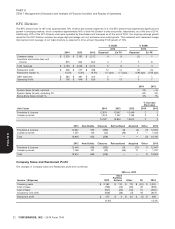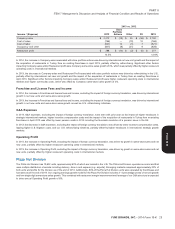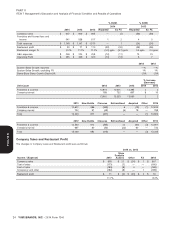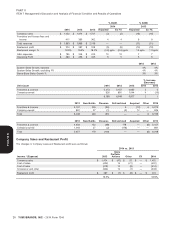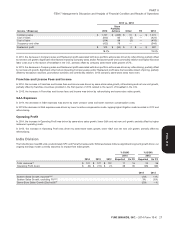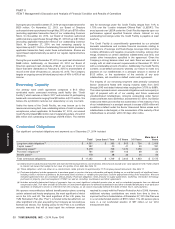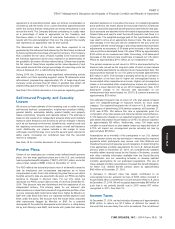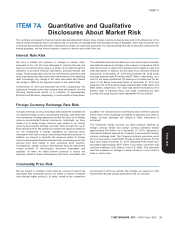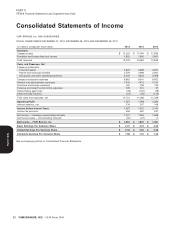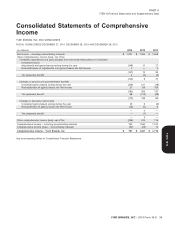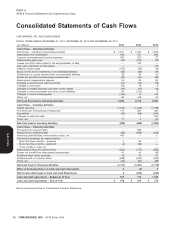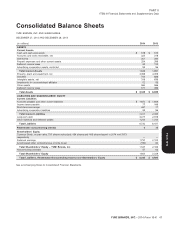Pizza Hut 2014 Annual Report Download - page 126
Download and view the complete annual report
Please find page 126 of the 2014 Pizza Hut annual report below. You can navigate through the pages in the report by either clicking on the pages listed below, or by using the keyword search tool below to find specific information within the annual report.
13MAR201517272138
PART II
ITEM 7 Management’s Discussion and Analysis of Financial Condition and Results of Operations
improvement as well as expectations as to the useful lives of the expected future after-tax cash flows from Company-owned restaurant
restaurant assets. These after-tax cash flows also include a deduction operations and franchise royalties.
for the anticipated, future royalties we would receive under a franchise Future cash flow estimates and the discount rate are the key
agreement with terms substantially at market entered into assumptions when estimating the fair value of a reporting unit. Future
simultaneously with the refranchising transaction. cash flows are based on growth expectations relative to recent
The discount rate used in the fair value calculations is our estimate of historical performance and incorporate sales growth and margin
the required rate of return that a franchisee would expect to receive improvement assumptions that we believe a third-party buyer would
when purchasing a similar restaurant or groups of restaurants and the assume when determining a purchase price for the reporting unit. The
related long-lived assets. The discount rate incorporates rates of sales growth and margin improvement assumptions that factor into
returns for historical refranchising market transactions and is the discounted cash flows are highly correlated as cash flow growth
commensurate with the risks and uncertainty inherent in the can be achieved through various interrelated strategies such as
forecasted cash flows. product pricing and restaurant productivity initiatives. The discount
rate is our estimate of the required rate of return that a third-party
We evaluate indefinite-lived intangible assets for impairment on an buyer would expect to receive when purchasing a business from us
annual basis or more often if an event occurs or circumstances that constitutes a reporting unit. We believe the discount rate is
change that indicates impairment might exist. We perform our annual commensurate with the risks and uncertainty inherent in the
test for impairment of our indefinite-lived intangible assets at the forecasted cash flows.
beginning of our fourth quarter. Fair value is an estimate of the price a
willing buyer would pay for the intangible asset and is generally Other than the Little Sheep reporting unit discussed below, the fair
estimated by discounting the expected future after-tax cash flows values of our other reporting units were substantially in excess of their
associated with the intangible asset. respective carrying values as of the 2014 goodwill testing date.
Our most significant indefinite-lived intangible asset is our Little Sheep As a result of our annual impairment testing we completely impaired
trademark with a book value of $60 million at December 27, 2014. We what was our most significant goodwill balance of $160 million related
recorded impairment charges in 2014 of $284 million to write the to our Little Sheep reporting unit in 2014. See the Little Sheep
trademark down to its estimated fair value. See the Little Sheep Acquisition and Subsequent Impairment section of Note 4 for details.
Acquisition and Subsequent Impairment section of Note 4 for details. The fair value of the Little Sheep reporting unit was based on the
No additional indefinite-lived intangible asset impairment was estimated price a willing buyer would pay, and was determined using
recorded in 2014. an income approach with future cash flow estimates generated by the
business as a significant input. Future cash flow estimates are
The fair value estimate of the Little Sheep trademark was based on primarily impacted by new unit development, sales growth and
the estimated price a willing buyer would pay for the asset and was ownership strategy. This fair value incorporated a discount rate of
determined using a relief from royalty valuation approach that 13% as our estimate of the required rate of return that a third-party
included future estimated sales as a significant input. The fair value buyer would expect to receive when purchasing the Little Sheep
incorporated a discount rate of 13% as our estimate of the required reporting unit.
rate of return that a third-party buyer would expect to receive when
purchasing the Little Sheep trademark. Little Sheep sales volumes and profit levels were significantly below
forecasted amounts in 2014. As this continued a trend of under
Little Sheep sales volumes and profit levels were significantly below performance for the business, a significant number of Company-
forecasted amounts in 2014. As this continued a trend of under operated restaurants were closed or refranchised during 2014 with
performance for the business, a significant number of Company- future plans calling for further focus on franchise-ownership for the
operated restaurants were closed or refranchised during 2014 with Concept. As such, the inputs used in determining the fair value for the
future plans calling for further focus on franchise-ownership for the Little Sheep reporting unit reflect a reduction in Company ownership
Concept. As such, the inputs used in determining the fair value for the to a level of 50 restaurants (from 92 restaurants at December 27,
Little Sheep trademark reflect a reduction in Company ownership to a 2014). Given so few Company-operated restaurants, the primary
level of 50 restaurants (from 92 restaurants at December 27, 2014). drivers of fair value in 2014 include franchise revenue growth and
Given so few Company-operated restaurants, the primary drivers of cash flows associated with a wholly-owned business that sells
fair value in 2014 include franchise revenue growth and revenues seasoning to retail customers. Franchise revenue growth reflects
from a wholly-owned business that sells seasoning to retail annual same-store sales growth of 4% and approximately 35 new
customers. Franchise revenue growth reflects annual same-store franchise units per year, partially offset by the impact of approximately
sales growth of 4% and approximately 35 new franchise units per 25 franchise closures per year. The seasoning business is forecasted
year, partially offset by the impact of approximately 25 franchise to generate sales growth rates and margins consistent with historical
closures per year. The seasoning business is forecasted to generate results.
sales growth rates consistent with historical results.
When we refranchise restaurants, we include goodwill in the carrying
amount of the restaurants disposed of based on the relative fair values
Impairment of Goodwill of the portion of the reporting unit disposed of in the refranchising
versus the portion of the reporting unit that will be retained. The fair
We evaluate goodwill for impairment on an annual basis as of the value of the portion of the reporting unit disposed of in a refranchising
beginning of our fourth quarter or more often if an event occurs or is determined by reference to the discounted value of the future cash
circumstances change that indicates impairment might exist. Goodwill flows expected to be generated by the restaurant and retained by the
is evaluated for impairment by determining whether the fair value of franchisee, which include a deduction for the anticipated, future
our reporting units exceed their carrying values. Our reporting units royalties the franchisee will pay us associated with the franchise
are our business units (which are aligned based on geography) in our agreement entered into simultaneously with the refranchising
KFC, Pizza Hut and Taco Bell Divisions and individual brands in our transaction. Appropriate adjustments are made to the fair value
China and India Divisions. Fair value is the price a willing buyer would determinations if such franchise agreement is determined to not be at
pay for the reporting unit, and is generally estimated using discounted prevailing market rates. When determining whether such franchise
32 YUM! BRANDS, INC. - 2014 Form 10-K
Form 10-K


